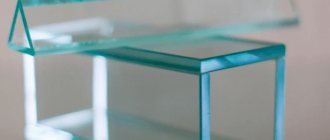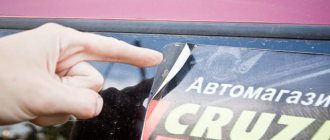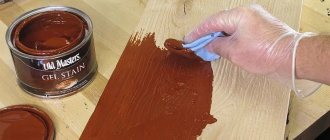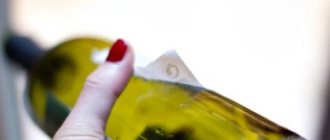The adhesive from the tint sticks firmly; removing it will require some effort.
Not all means can cope with it. It is forbidden to leave sticky marks on the glass, as they not only worsen the appearance of the car, but can also cause damage to the window regulators. Dust and small insects will settle on them.
Read the article on how to remove tinting glue from glass.
Removing tint with a hairdryer
How to remove the film itself? You'll have to remember your school chemistry course. The film consists of a polymer material, and all polymers are destroyed when heated. It turns out that to carefully remove the film you need to heat it with a stream of hot air. Any hair dryer that is usually used to dry hair is suitable for this. In this way, you can peel off the tint almost without streaks.
The main thing is not to exceed the temperature of 40 degrees Celsius, otherwise the film will melt and stick tightly. Or the glass will simply burst. The method is practically professional, relatively affordable and working.
The procedure consists of several stages:
- First, the side window lowers a little.
- All rubber seals are removed.
- Using a hair dryer, the surface of the glass is heated so that the film softens but does not melt.
- Then it is pryed with a knife and moved slightly to the side.
- The film is gradually removed from the entire surface.
Now let's look at popular methods for removing glue from the surface of glass.
How to remove glue from tint
For many drivers, sticky tint stains are a big problem. They wonder how to remove them without damaging the glass or the car itself.
When removing tinting glue, you should not do it yourself, as this can lead to unpleasant consequences. Set a clear plan for what you will do. Follow this plan strictly.
Using soap solution
As a preparation, you can use almost any detergent at hand. The work consists of steps:
- Tinted glass is coated with a solution. Then newspaper is applied to the wet surface, which quickly sticks.
- For 2 hours, the newspaper is constantly wetted with the solution.
- This leads to a softening of the tint. As a result, the film can be easily removed together with the newspaper.
The advantage of this method is that there is no need to search for a soap solution.
Mechanical methods
The problem associated with removing the remaining sticky layer from tinting can be prevented at the stage of dismantling the film. When the coating is removed correctly, no more than 10–20% of the composition remains on the surface, which is subsequently quickly and easily removed. The main techniques that allow you to perform the operation as accurately and efficiently as possible are:
- Method using industrial hair dryers. It is rational to use for films with an adhesive layer such as CD. Removal of the coating is carried out by heating to 40–60°C and removing areas of tinting. You can also do the work using a household hair dryer, but you should remember that this device is not intended for long-term continuous operation. The disadvantages of this method include the negative impact of elevated temperatures on parts associated with glass - seals and decorative overlays. These elements can be deformed under the influence of spot heating. To protect structural elements, they are covered with a damp rag or completely removed.
- Method using soap solution and scrapers. To work, you will need a thin knife, a spatula or similar means, and a spray bottle with a mixture of detergent and water. Having lifted the edge of the film, the master constantly wets the tear line and detaches the canvas in small sections.
Even after the most careful removal of the film, glue stains and entire areas of adhesive coating may remain.
Remnants of the adhesive layer that still remain on the glass can be removed mechanically using:
- Mild steel scrapers, blade. The edge should be at an angle of 30–40 degrees to the surface. It is necessary to clean off the layer without pressure, with smooth movements. The adhesive is easiest to clean immediately after heating and detaching the film, so it is advisable to carry out the cleaning operation immediately after removing the tint.
- Depending on the removal method, the adhesive composition can be removed in layers, or it can crumble into solid crumbs
- Soft abrasives. The contaminated area is treated with a concentrated soap solution, for example, household detergent. After it has dried, the composition is applied again and cleaned off with the rough side of a kitchen sponge.
Advice. When using these methods, the motorist should be especially careful. Otherwise, micro-scratches may form on the surface. Due to the risk of damaging the electrical heating filaments, it is not advisable to use mechanical cleaning methods on the rear window.
Using ammonia
This work is carried out on a sunny day using ammonia. The work order consists of stages:
- A soap solution is diluted to cover the glass. Ammonia is applied on top.
- Small pieces of polyethylene are cut, which after wetting in ammonia are glued to the glass.
- Ammonia and sunlight affect the film. Over time it softens. After this, removing it is not difficult.
This method is harmful to health, so work must be carried out exclusively in a respirator. Ammonia vapors are dangerous.
How to remove tint correctly (for the future)
To leave a minimum of glue from the film, you need to know how to properly peel off the tint from the glass. To carry out dismantling you need to prepare: A hair dryer, a stationery knife. The procedure is performed as follows: Using a utility knife, pry up the corner of the tint film so that you can pick it up with your fingers. Heat the hairdryer to 300-400°C.
Pre-warm the work site. Start pulling the film with gentle force. The heated glue liquefies and lags behind the glass.
Cut off large pieces of the removed film with a utility knife, this will simplify the process. You can easily wipe off the glue after removing the tint film if you choose the right method. To avoid damaging the glass, you must use only proven methods and means.
You can simplify the procedure and minimize the amount of glue residue by properly dismantling the tint film.
Traditional methods of removing glue
In principle, you can also quickly and barbarically tear off the coating, but then sticky traces of glue will remain. How to remove them:
- alcohol glass cleaner;
- soap solution mixed with ammonia (take care of your respiratory system!);
- use a hair dryer and spray bottle to speed up the process;
- Prepare a cleaning solution from dishwashing liquid.
In some situations, even ordinary boiling water fresh from the kettle will help. But this method is only good when it’s warm outside: in winter, such experiments can cause the glass to crack. Just pour a little water on the areas with traces of glue and it will come off.
Porous fabrics (bandage, gauze) remove glue well. Often they don’t need to be impregnated with anything if the tint was removed recently and the glue has not dried. They themselves absorb dirt well. To speed up the process, it is enough to use a biosolvent.
You can use WD40 (rust converter) fluid in combination with a melamine sponge. The result is one hundred percent. You can also prepare a soap solution with formic alcohol instead of ammonia: this will allow you not to wear a respirator and not have to endure the pungent smell of the volatile substance. Just in case, it is better to wear gloves and safety glasses: chemistry is chemistry, even if it seems safe.
Basic DIY removal methods
1) Guys, if you find yourself in a situation with a traffic police officer, then try to rip off the film in one motion - you need to pry off the edge with a knife, then take the film with both hands and sharply pull it down as far as you can. It will not be possible to get rid of the adhesive completely, but much less of it will remain.
2) If you have time, you need to pry off the edge of the canvas with a knife and, using soapy water, slowly remove it from the glass. Soapy water is added to the separation area and watered generously so that some of the glue remains on the film.
By the way, here is a useful video where a guy scrubbed with a regular dishwashing sponge.
BUT still, it won’t be possible to completely remove it; some of the glue will remain on the glass; it needs to be wiped off differently. But you need to clean it, because you can easily break the window regulators; they will not work because there is glue on the canvas, which will not allow the glass to go down. YES, everything will stick, from dust to all sorts of midges.
Professional products
Currently, many special products are produced for removing glue from glass. For example, aerosol film removers. They are mostly toxic and quite expensive, but they are fast-acting. Here is a sample list of popular chemicals:
- spray “Kerry”;
- “The Anticlean Moment”;
- rust converter “Star Wax”;
- anti-rain Turtle Wax Clear;
- sticker trace cleaner (these are produced under the brands Liqui Moly, Kudo, Spray&Go).
The listed products help to effectively get rid of the marks left by glass tinting glue. Their advantages:
- their active formula is specially designed to remove adhesive stains;
- high quality;
- they are easy to apply;
- some of them have the ability to repel water and work as an anti-rain.
Reasons for removing film
Peeling off the tint film is a very labor-intensive process that needs to be approached no less seriously than gluing it. So the removal methods will largely depend on the reason why you need to remove the old tint. Because a relatively freshly applied film is much easier to remove than an old one. And so let’s get acquainted with the most common reasons for its removal.
Reasons for removing film:
- If you notice that the film has begun to fade, peel off, or some defects have formed , for example, air bubbles, or it has simply changed its color , then it is clear that there is no point in leaving it on the glass, because it has already lost its functions anyway and the appearance too. Basically, a change in color can occur when using non-metallic dyes in tinting, and the appearance of bubbles, in turn, is due to poor adhesion of the tinting to the window or poor-quality glue.
- If after purchasing a car you find that the film is too dark, then it also needs to be changed, since it may not meet the standards. The traffic rules state that glass tinting is allowed only within permissible standards, that is, the light transmittance of the windshield should not be lower than 75% , for all other glasses the lower limit is 70%. In addition, there may be a light-protecting strip no more than 15 centimeters wide on the windshield . If you are stopped on the road by traffic police officers and notice this violation, then you cannot avoid the corresponding sanctions in the form of a fine.
- Also, removing the tint is necessary if a chip or crack appears on the glass and you are going to fix it to prevent it from spreading further.
Petroleum-containing compounds
Various mixtures of hydrocarbons are known for their solvent effect. They are used to remove traces of stickers, tape, paint and other stubborn dirt. It should be remembered that they are aggressive towards the paintwork of the car. These substances are liquids:
- petrol;
- kerosene;
- white spirit (nefras).
The algorithm for removing glue using these hydrocarbons is as follows:
- Stock up on clean rags;
- Wipe off dirt with a dampened rag;
- Wash the glass with clean water and wipe dry.
You need to work with hydrocarbon liquids with extreme care: they are toxic, volatile, flammable and can damage the paint if they come into contact with body parts.
Super glue
This word refers to acrylate-based adhesion chemicals. They dry quickly and adhere firmly to the surface.
To remove glue from glass, you will need solvents:
- Acetone . The greatest effectiveness is achieved when removing fresh super glue, but you can also try to remove hardened formations. Cover the drip with a rag or cotton wool soaked in cleaner. After 10-15 minutes. try to pry the glue with a spatula (blade) and separate it from the surface. Dry areas are additionally moistened with acetone.
- Paint removers . White spirit and numbered solvents (646, 647) are used similarly to acetone.
The products are not intended for matte or painted products. Do not use solvent to remove dirt from car glass after applying the tint - the chemical will corrode the film. Before use, the solvent should be tested on a sample of the material or an inconspicuous area.
Car detonation service
Turning to professionals for help is a smarter decision than removing the tint yourself. Control over car tinting is being strengthened, fines are rising, and drivers are worried. In addition, tint sometimes wears out over time and needs to be renewed. But not everyone has the equipment and free time for this.
The price of tinting per unit at River Auto Lab is 500 rubles. You can be sure that the windows of your car will not be damaged at all. The entire process of glass tinting is carried out in full accordance with technology, which guarantees high quality work even when tinting glass with electrical heating.
How to remove tinting from a rear window without damaging the heating
Removing the tint film on the side windows is much easier and faster than doing it on the rear, especially if it is heated. Therefore, we will pay special attention and tell you about the nuances of how to remove the tinting film from the rear window without damaging the heating, interior trim and decorative panels. Let's reveal a few tricks.
In most cases, rear windows are heated in the form of special thin threads. So when removing the film from the glass, there is no need to make sudden movements , because the heating elements can be damaged. Only heating and using a soap (alkaline) solution to avoid negative consequences when removing the film . Therefore, if you don’t have a hairdryer, just turn on the glass heating . Under the influence of heat, the glue will become softer and can be easily removed from the glass without damaging the heating filaments.
It is allowed to heat the glass with a hairdryer at temperatures above 0 degrees, otherwise it may burst. Therefore, it is not recommended to remove tinting in winter.
Another simple and reliable method to get rid of tinting on heated glass is to use the ammonia removal method (described above). Or even ordinary soapy water using cling film. But spraying water and gluing the film on top will delay the removal of the tint for a couple of days (this is exactly how long it takes for the water to penetrate behind the film and for it to come off).
As you can see, everything can be done with your own hands, if only you are attentive and careful with your vehicle. If you carry out all the actions strictly according to the instructions, then you will not damage anything in the car, but if this process still seems difficult for you, then it is better to turn to professionals, but then you will have to spend 2 - 3 thousand rubles.
Silicone adhesives
Moment adhesive and other silicone-based products adhere firmly to the glass surface when hardened. In addition to solvents used to remove other fastening compounds, gasoline and kerosene are used to remove them. The top layer is carefully cut off; the blade should not come into contact with the glass. Apply solvent to the remaining part of the glue for a few minutes. The softened dirt is washed off.
The material may also be susceptible to heat. The work of a glue gun is based on this - under the influence of high temperatures, silicone rods melt, holding the parts together after hardening.
Moment adhesive is designed for use at temperatures up to +120 °C; it is dangerous to heat glass to this state. You can try to remove less heat-resistant compounds from small surfaces (glass glasses, photo frames, vases) by softening them with a hairdryer.
The frozen silicone is removed from the seams with a knife with a sharp, short blade, scraping off most of the glue from the ends.











